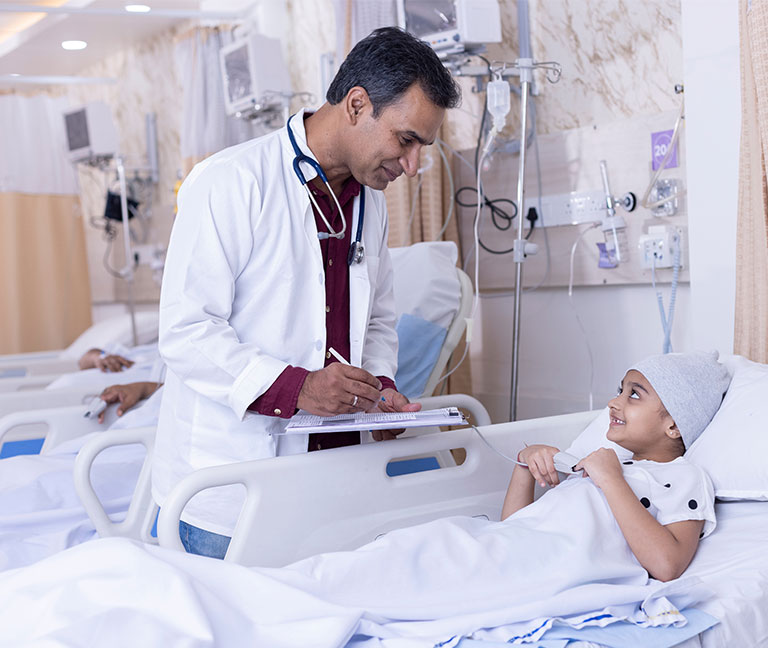Why Surgery Is Sometimes The Best Or Only Suitable Treatment For Pediatric Brain Tumours?
Children's brains can develop pediatric brain tumours, which are lumps or growths of aberrant cells that affect the brain or nearby tissues and systems. There are numerous varieties of juvenile brain tumours, some of which are benign (noncancerous) and others of which are malignant (malignant).
Infants under the age of six months seldom develop brain tumours. Despite the fact that pediatric brain tumours have been extensively studied, there isn't much research that has explicitly focused on infants under the age of six months.
Interdisciplinary treatment is necessary for extremely young children with malignant brain tumours. Surgery is still a crucial part of the majority of treatment plans.
Symptoms Of Pediatric Brain Tumour
The brain is the only organ with extra space in the skull. Consequently, as brain tumours grow and expand, they increase the pressure inside this little region. Intracranial pressure is the term for this.
Extra brain tissue and obstructions in the cerebrospinal fluid flow channels both contribute to elevated intracranial pressure.
Here are some of the symptoms of a brain tumour in pediatric:
- Headaches
- Seizures
- Nausea and vomiting
- Irritability
- Lethargy and drowsiness
- Personality and mental activity changes
- Macrocephaly (enlarged head) in infants whose skull bones are not completely fused
Causes Of Pediatric Brain Tumor
The precise cause of a pediatric brain tumour is typically unknown.
Primary brain tumours, or those that begin in the brain or in tissues near it, are the most common type of tumour in children. When DNA errors (mutations) occur in normal cells, primary brain tumours develop. These mutations prevent healthy cells from dying and allow cells to proliferate and replicate more quickly. A tumour is a consequence, which is a mass of aberrant cells.
Children can develop a variety of brain tumours, some of which may or may not be cancerous.
Most Common Pediatric Brain Tumours
Various types of brain tumours include:
- Primary: beginning in the brain
- Metastatic: Beginning in one part of the organism and moving to another, including the brain
- Benign: Noncancerous; slow-growing. If benign tumours are developing inside or close to specific brain areas, treatment can still be challenging.
- Malignant: Having cancer. Malignant tumours can be exceedingly aggressive, in contrast to benign tumours, which usually remain circumscribed. They develop quickly and can spread to the brain's other regions as well as to regions close to the original tumour.
Treatment For Brain Tumour
The type, size, and location of the brain tumour, your child's age, and general health all play a role in how it will be treated.
The child's pediatric neurosurgeon will try to remove as much of the brain tumour as safely possible if the tumour is at a site that can be operated on.
When tumours are tiny and simple to remove from surrounding brain tissue, total surgical excision is sometimes possible. Other times, tumours are too closely bound to the surrounding tissue or are situated close to delicate brain regions, making surgery dangerous. The pediatric neurosurgeon in these cases removes the maximum amount of the tumour.
Even partial brain tumour removal could lessen indications and symptoms. There are dangers associated with juvenile brain tumour surgery, including bleeding and infection. Depending on where the area of the child's brain the tumour is in, there may be additional hazards. For instance, surgery on a tumour close to the nerves that supply the eyes could result in visual loss.
Pediatric Brain Surgery Recovery
Every youngster goes through a different healing process. After surgery, children who get a quick diagnosis and pediatric brain tumor treatment can recover well.
Children may occasionally suffer from neurological impairments like muscle weakness. Unless there was significant irreversible damage before the child was diagnosed, this usually goes away immediately after surgery. Strength, function, and recovery time can all be helped by physical, occupational, and speech therapy.
Regular post-operative follow-up appointments with the child's neurosurgeon are crucial to track neurological function, track medication adverse effects, and prevent tumour recurrence.
Sources:
- https://www.mayoclinic.org/diseases-conditions/pediatric-brain-tumor/symptoms-causes/syc-20361694#:~:text=Pediatric%20brain%20tumors%20are%20masses,some%20are%20cancerous%20(malignant).
- https://www.ncbi.nlm.nih.gov/pmc/articles/PMC3292637/
- https://www.mayoclinic.org/diseases-conditions/pediatric-brain-tumor/diagnosis-treatment/drc-20361706
- https://www.hopkinsmedicine.org/health/conditions-and-diseases/brain-tumor/pediatric-brain-tumors





